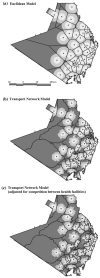Modelling distances travelled to government health services in Kenya
- PMID: 16451343
- PMCID: PMC2912494
- DOI: 10.1111/j.1365-3156.2005.01555.x
Modelling distances travelled to government health services in Kenya
Abstract
Objective: To systematically evaluate descriptive measures of spatial access to medical treatment, as part of the millennium development goals to reduce the burden of HIV/AIDS, tuberculosis and malaria.
Methods: We obtained high-resolution spatial and epidemiological data on health services, population, transport network, topography, land cover and paediatric fever treatment in four Kenyan districts to develop access and use models for government health services in Kenya. Community survey data were used to model use of government health services by febrile children. A model based on the transport network was then implemented and adjusted for actual use patterns. We compared the predictive accuracy of this refined model to that of Euclidean distance metrics. RESULTS Higher-order facilities were more attractive to patients (54%, 58% and 60% in three scenarios) than lower-order ones. The transport network model, adjusted for competition between facilities, was most accurate and selected as the best-fit model. It estimated that 63% of the population of the study districts were within the 1 h national access benchmark, against 82% estimated by the Euclidean model.
Conclusions: Extrapolating the results from the best-fit model in study districts to the national level shows that approximately six million people are currently incorrectly estimated to have access to government health services within 1 h. Simple Euclidean distance assumptions, which underpin needs assessments and against which millennium development goals are evaluated, thus require reconsideration.
Figures




 = government health facility;
= government health facility;  = catchment area;
= catchment area;  = 0-0.5 hours;
= 0-0.5 hours;  = >0.5–1 h;
= >0.5–1 h;  = >1 hour. All maps are at the same scale as shown on Figure 4a. The North direction is towards the top of the page.
= >1 hour. All maps are at the same scale as shown on Figure 4a. The North direction is towards the top of the page.Similar articles
-
Defining equity in physical access to clinical services using geographical information systems as part of malaria planning and monitoring in Kenya.Trop Med Int Health. 2003 Oct;8(10):917-26. doi: 10.1046/j.1365-3156.2003.01112.x. Trop Med Int Health. 2003. PMID: 14516303 Free PMC article.
-
Univariate and multivariate spatial models of health facility utilisation for childhood fevers in an area on the coast of Kenya.Int J Health Geogr. 2017 Sep 18;16(1):34. doi: 10.1186/s12942-017-0107-7. Int J Health Geogr. 2017. PMID: 28923070 Free PMC article.
-
Geographic access to care is not a determinant of child mortality in a rural Kenyan setting with high health facility density.BMC Public Health. 2010 Mar 17;10:142. doi: 10.1186/1471-2458-10-142. BMC Public Health. 2010. PMID: 20236537 Free PMC article.
-
Heterogeneity in health seeking behaviour for treatment, prevention and urgent care in four districts in western Kenya.Public Health. 2014 Nov;128(11):993-1008. doi: 10.1016/j.puhe.2014.08.010. Epub 2014 Nov 18. Public Health. 2014. PMID: 25443099
-
Tuberculosis.In: Holmes KK, Bertozzi S, Bloom BR, Jha P, editors. Major Infectious Diseases. 3rd edition. Washington (DC): The International Bank for Reconstruction and Development / The World Bank; 2017 Nov 3. Chapter 11. In: Holmes KK, Bertozzi S, Bloom BR, Jha P, editors. Major Infectious Diseases. 3rd edition. Washington (DC): The International Bank for Reconstruction and Development / The World Bank; 2017 Nov 3. Chapter 11. PMID: 30212088 Free Books & Documents. Review.
Cited by
-
Geographical accessibility and spatial coverage modelling of public health care network in rural and remote India.PLoS One. 2020 Oct 21;15(10):e0239326. doi: 10.1371/journal.pone.0239326. eCollection 2020. PLoS One. 2020. PMID: 33085682 Free PMC article.
-
Assessing mental health literacy of primary health care workers in Kenya: a cross-sectional survey.Int J Ment Health Syst. 2021 Jun 1;15(1):55. doi: 10.1186/s13033-021-00481-z. Int J Ment Health Syst. 2021. PMID: 34074318 Free PMC article.
-
Examining inequalities in spatial access to national health insurance fund contracted facilities in Kenya.Int J Equity Health. 2024 Apr 18;23(1):78. doi: 10.1186/s12939-024-02171-x. Int J Equity Health. 2024. PMID: 38637821 Free PMC article.
-
Discovering the cost of care: consumer, provider, and retailer surveys shed light on the determinants of malaria health-seeking behaviours.Malar J. 2016 Mar 22;15:179. doi: 10.1186/s12936-016-1232-7. Malar J. 2016. PMID: 27006074 Free PMC article.
-
Barriers to access for severe acute malnutrition treatment services in Pakistan and Ethiopia: a comparative qualitative analysis.Public Health Nutr. 2015 Jul;18(10):1873-82. doi: 10.1017/S1368980014002444. Public Health Nutr. 2015. PMID: 26017477 Free PMC article.
References
-
- Akin JS, Hutchinson P. Health-care facility choice and the phenomena of by-passing. Health Policy and Planning. 1999;14:135–151. - PubMed
-
- Amooti-Kaguna B, Nuwaha F. Factors influencing choice of delivery sites in Rakai district of Uganda. Social Science and Medicine. 2000;50:2033. - PubMed
-
- Amin AA, Marsh V, Noor AM, Ochola SA, Snow RW. The use of formal and informal curative services in the management of paediatric fever in four districts in Kenya. Tropical Medicine and International Health. 2003;8:1143–1152. - PubMed
-
- Bailey W, Phillips DR. Spatial patterns of use of health services in the Kingston metropolitan area, Jamaica. Social Science and Medicine. 1990;30:1–12. - PubMed
-
- Black R, Morris S, Bryce J. Where and why are 10 million children dying every year? Lancet. 2003;361:2226–2234. - PubMed
Publication types
MeSH terms
Grants and funding
LinkOut - more resources
Full Text Sources
Medical

